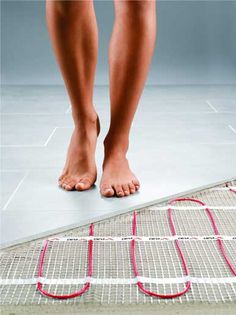Heated Flooring
Posted by Matt Brooke on October 23, 2015

A few years ago, one of the more decedent things a client could request would be a heated flooring system. Today the technology of heated floors has improved and the installation is more streamlined and much more affordable. What once seemed like an over the top luxury can now be enjoyed as a welcome feature to many renovations.
The principal is simple: The floor radiates heat to your feet, warming you all over. Most familiar are hydronic systems that heat your entire house. They produce wonderful heat, but they require serpentine runs of plastic tubing, water heaters or boilers, pumps and manifolds. This makes hydronic systems expensive and complicated to install. A simpler, less expensive alternative for just a single room is one of the electric systems discussed here.
An electric radiant system consists of thin heating cables, like the wires in an electric blanket, installed under ceramic tile. Because the cables are so thin they don’t raise the level of the flooring much; this makes them great for remodeling. They’re installed where warm floors are appreciated: bathrooms, mudrooms, and kitchens. Controlled by their own thermostat, these systems don’t replace your main heating unit — they augment it. To install an electric radiant floor in an existing room, you’ll need a dedicated 15- to 20-amp GFCI-protected circuit to power the system, and an excuse to lay a new tile floor. If you’re remodeling, it’s a good time to satisfy both requirements. This system will consume about the same amount of electricity as three 100W lightbulbs.
One of the systems we like to use is made by Shluter. Their Ditra-Heat membrane is available in both mat and roll formats and is designed to secure the system heating cables and serves as a universal substrate for tile coverings. This application provides uncoupling to neutralize the differential movement stresses between the substrate and the tile covering to prevent cracked grout and tile, waterproofing to protect moisture-sensitive substrates, vapor management, and support. The twisted pair heating cable is available in 120 and 240 Volt formats. The cables can be installed without returning to the thermostat and produce virtually no electromagnetic fields. The digital thermostat controls the floor temperature and is offered in both a programmable and non-programmable format. The thermostats feature a built-in Ground Fault Circuit Interrupter (GFCI), digital display with backlit screen, and support both the 120 and 240 Volt cables. The programmable thermostat also includes 250 preset programs.
Your winter could be a lot warmer with a little floor heat!







